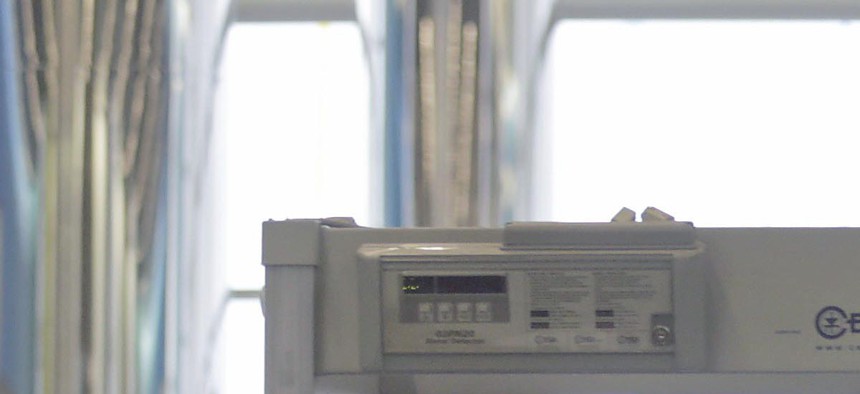
Passengers are scanned at a security checkpoint at Logan Airport, in Boston, on October 24, 2012. Charles Krupa/AP
The CIA Has a Problem With Biometric Surveillance
The growing use of digital fingerprint matching at European airports troubles Langley. By Aliya Sternstein
Some tactics that CIA operatives use to avoid blowing their cover at airports could be foiled by one of the spy agency’s best surveillance tools: biometric identification.
The growing use of digital fingerprint matching at European airports troubles Langley, according to January 2012 CIA guidelines for using fake IDs that Wikileaks released on Sunday.
The agency’s discontent could present an awkward situation for the Department of Homeland Security. DHS is assisting with the rollout of biometric screening at borders worldwide, including in Europe.
The region of concern, called the Schengen area, covers most of the European Union, along with Iceland, Norway, Switzerland and Liechtenstein.
Right now, according to “CIA Advice for US Government Operatives Infiltrating Schengen," the region's travel system presents minor obstacles, because unofficial persons are not required to carry visas.
But that is expected to change.
In 2015, a new entry-exit system that mandates fingerprint identification is scheduled to go live, the guidelines note: "The European Commission is considering requiring travelers who do not require visas to provide biometric data at their first place of entry into the Schengen area, which would increase the identity threat level for all U.S. travelers” – spies included.
In October, border control stations at Zurich Airport were outfitted with fingerprint readers to screen visitors. The project "rigorously implements the current requirements of the Schengen Borders Code and is equipped to meet future standards," Heinz Lusti, a project leader with the airport division of the Zurich Cantonal Police, said in a statement.
Russia recently announced a similar fingerprint directive for foreigners, in response to Europe’s policy.
Some U.S. national security experts say the CIA just has to deal.
“It contradicts what at least should be U.S. policy in supporting more secure borders around the world by saying -- for our very, very narrow purposes and to the exclusion of the rest of the world, we don’t want biometrics in the Schengen area,” said Janice Kephart, border counsel to the 9/11 Commission. “It’s extremely narrow-minded.”
Those checkpoint upgrades will provide biometric data on tourists that is valuable to both the CIA and Schengen partners, she said.
Operatives already have learned techniques to circumvent biometric ID rules in other countries, Kephart added, declining to go into specifics for national security reasons.
“So they really don’t have anything to complain about,” she said. “It will affect their operations in the Schengen area, but they’ve already been dealing with this in other countries so they can basically just adjust.”
The CIA's discomfort with biometric-based screening abroad is unlikely to interfere with DHS’ plans to expand the technology, said Kephart, now CEO of the Secure Identity & Biometrics Association.
“Biometrics has changed their operational intelligence dramatically in the field for the better, being able to learn -- often in close to real-time -- who it is they are really dealing with. The CIA knows this better than anyone," she said.
Foreign spies entering the United States are subject to the same fingerprint test. By law, almost all international visitors to the U.S. are required to submit their prints for entry.
CIA officials declined to comment on the Wikileaks disclosures or the expanded use of biometric identification abroad.
DHS officials were not able to comment immediately.




